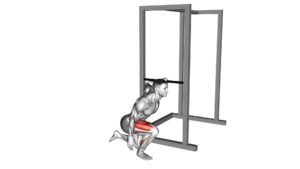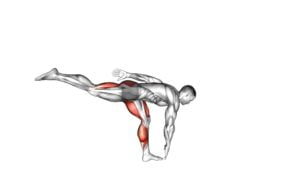Bodyweight Single Leg Squat (male) – Video Exercise Guide & Tips

Are you looking for an effective lower body exercise that targets your quads, glutes, and hamstrings? Look no further than the bodyweight single leg squat!
Watch This Exercise Video
This exercise, demonstrated in our video guide, is perfect for men of all fitness levels. By using your own body weight, you can build strength and stability while improving balance and coordination.
In this article, we'll provide you with valuable tips and techniques to ensure you get the most out of your bodyweight single leg squats.
Let's get started!
Key Takeaways
- The Bodyweight Single Leg Squat targets quadriceps, hamstrings, and glutes.
- It improves balance, stability, and overall athletic performance.
- Proper form and technique are crucial to avoid common mistakes and maximize effectiveness.
- Progressions and variations allow for customization based on fitness levels and goals.
Benefits of the Bodyweight Single Leg Squat
You can experience several benefits from incorporating the bodyweight single leg squat into your workout routine. This exercise primarily targets your quadriceps, hamstrings, and glutes, helping to build strength and improve muscle definition in these areas. By working each leg individually, you can also identify and correct any muscular imbalances that may exist between your left and right sides. Additionally, the bodyweight single leg squat can improve your balance and stability, as it requires you to engage your core and maintain control throughout the movement.
Modifications can be made to suit your fitness level and goals. If you're new to this exercise, you can start by holding onto a stable surface, such as a wall or chair, for support. As you become more comfortable, you can progress to performing the exercise without any assistance. To increase the difficulty, you can hold a dumbbell or kettlebell in your hands or perform the exercise on an unstable surface, such as a balance pad or BOSU ball. Remember to always maintain proper form and listen to your body.
Incorporating the bodyweight single leg squat into your workout routine can provide you with a variety of benefits, including increased leg strength, improved balance and stability, and the opportunity to correct any muscular imbalances. With modifications available to suit your needs, this exercise can be a valuable addition to your fitness regimen.
Proper Form and Technique for the Exercise
Executing the bodyweight single leg squat requires maintaining proper form and technique throughout the exercise. This not only ensures maximum effectiveness but also minimizes the risk of injury.
To start, stand on one foot with the other leg extended slightly in front of you. Keep your chest up and engage your core for stability. As you lower yourself down, focus on keeping your knee aligned with your toes and your weight centered over your supporting leg. Aim to lower your body until your thigh is parallel to the ground, or as close as you can comfortably go.
To return to the starting position, push through your heel and engage your glutes and thigh muscles.
The bodyweight single leg squat is an excellent exercise for improving balance and targeting specific muscle groups, including the quadriceps, hamstrings, and glutes. By practicing proper form and technique, you can maximize the benefits of this exercise and achieve optimal results.
Progressions and Variations for All Fitness Levels
To progress and vary the bodyweight single leg squat exercise for all fitness levels, try incorporating different modifications and challenges. Here are some options to consider:
- Modifications and regressions for beginners:
- Use a support: Hold onto a stable object, such as a wall or chair, to assist with balance and stability.
- Reduce range of motion: Perform the exercise with a smaller squat depth to make it more manageable for beginners.
- Advanced variations for experienced athletes:
- Pistol squat: Extend one leg straight out in front of you while performing the squat, adding an extra challenge to your balance and strength.
- Weighted single leg squat: Hold a dumbbell or kettlebell in your hands or use a weighted vest to increase the resistance and difficulty of the exercise.
By incorporating these modifications and advanced variations, you can cater the bodyweight single leg squat to your current fitness level. Remember to always listen to your body and progress at a pace that feels comfortable and challenging.
Now let's discuss some common mistakes to avoid while performing the exercise.
Common Mistakes to Avoid While Performing the Exercise
When performing the bodyweight single leg squat exercise, it's important to be aware of common mistakes that can hinder your progress and potentially lead to injury.
One common mistake to avoid isn't maintaining proper form. It's important to keep your back straight and core engaged throughout the entire movement. Leaning forward or rounding your back can put unnecessary strain on your lower back and increase the risk of injury.
Another mistake to watch out for isn't fully extending your standing leg at the top of the movement. Make sure to fully straighten your leg before starting the next repetition to ensure you're engaging the proper muscles.
Lastly, avoid rushing through the exercise and sacrificing proper form for speed. Take your time and focus on performing each repetition with control and stability.
By avoiding these common mistakes and maintaining proper form, you can maximize the effectiveness of the bodyweight single leg squat exercise and reduce the risk of injury.
Now, let's move on to some tips for maximizing the effectiveness of this exercise.
Tips for Maximizing the Effectiveness of the Bodyweight Single Leg Squat
To maximize the effectiveness of the bodyweight single leg squat, focus on maintaining proper balance throughout the exercise. Here are some tips to help you get the most out of this exercise:
- Keep your core engaged: Engaging your core muscles will help you maintain stability and control throughout the movement.
- Start with a shallow range of motion: If you're new to single leg squats or have any knee issues, start by performing the exercise with a limited range of motion. Gradually increase the depth as you get stronger and more comfortable.
- Use proper form: Make sure your knee stays in line with your toes and doesn't collapse inward. Also, keep your chest up and back straight to avoid rounding your spine.
- Avoid rushing: Take your time and focus on the quality of each repetition rather than the quantity. It's better to perform the exercise with proper form and control, even if it means doing fewer reps.
- Common misconceptions: Contrary to popular belief, you don't need to hold weights or use fancy equipment to make this exercise effective. Your bodyweight alone can provide enough resistance to challenge your muscles.
- Modifications for injury prevention: If you have any knee or ankle injuries, consider performing the exercise with the support of a chair or bench to reduce the load on your joints. You can also consult with a qualified fitness professional for personalized modifications.
Frequently Asked Questions
How Many Calories Does the Bodyweight Single Leg Squat Burn?
When it comes to burning calories, the bodyweight single leg squat is a great exercise. This exercise targets multiple muscle groups, including the quads, glutes, and hamstrings, which helps to increase calorie burn.
Bodyweight exercises, like the single leg squat, have many benefits, such as improving balance, strength, and stability. Incorporating these types of exercises into your routine can be a great way to burn calories and improve overall fitness.
Can the Bodyweight Single Leg Squat Help Improve Balance and Stability?
Improving stability and balance are some of the benefits of single leg exercises like the bodyweight single leg squat. By focusing on one leg at a time, you challenge your muscles and engage your core to maintain stability.
This exercise also helps to improve coordination and proprioception, which are essential for overall balance.
Incorporating bodyweight single leg squats into your workout routine can be an effective way to enhance your stability and overall fitness.
Is It Necessary to Warm up Before Performing the Bodyweight Single Leg Squat?
Before performing the bodyweight single leg squat, it's necessary for you to warm up. Warming up has many benefits, such as increasing blood flow to your muscles and preparing them for the exercise. It can help prevent injuries and improve your overall performance.
If you're looking for alternative exercises, you can try lunges or step-ups, which also target your leg muscles and improve balance and stability.
Remember to always listen to your body and start with a proper warm-up routine.
Can the Bodyweight Single Leg Squat Be Modified for Individuals With Knee or Hip Pain?
To modify the bodyweight single leg squat for knee or hip pain, there are alternative movements and modified exercises you can try. These modifications can help reduce strain on the affected joints and still provide a challenging workout.
By consulting with a fitness professional or physical therapist, they can provide you with personalized modifications that suit your specific needs and limitations.
Remember to always prioritize your safety and listen to your body when performing any exercise.
How Often Should the Bodyweight Single Leg Squat Be Incorporated Into a Workout Routine for Optimal Results?
To achieve optimal results, it's important to incorporate the bodyweight single leg squat into your workout routine with the right frequency.
By including this exercise regularly, you can enhance lower body strength and stability.
However, it's essential to listen to your body and avoid overtraining.
Consider starting with 2-3 sessions per week and gradually increase as you feel comfortable.
Remember to consult a fitness professional for variations and progressions tailored to your fitness level.
Conclusion
In conclusion, the bodyweight single leg squat is a highly effective exercise for building lower body strength and stability. By maintaining proper form and technique, and progressing at your own pace, you can adapt this exercise to fit your fitness level.
Avoid common mistakes such as leaning forward or allowing your knee to collapse inward. To maximize the effectiveness, focus on engaging your core and maintaining balance throughout the movement.

Author
Years ago, the spark of my life’s passion ignited in my mind the moment I stepped into the local gym for the first time. The inaugural bead of perspiration, the initial endeavor, the very first surge of endorphins, and a sense of pride that washed over me post-workout marked the beginning of my deep-seated interest in strength sports, fitness, and sports nutrition. This very curiosity blossomed rapidly into a profound fascination, propelling me to earn a Master’s degree in Physical Education from the Academy of Physical Education in Krakow, followed by a Sports Manager diploma from the Jagiellonian University. My journey of growth led me to gain more specialized qualifications, such as being a certified personal trainer with a focus on sports dietetics, a lifeguard, and an instructor for wellness and corrective gymnastics. Theoretical knowledge paired seamlessly with practical experience, reinforcing my belief that the transformation of individuals under my guidance was also a reflection of my personal growth. This belief holds true even today. Each day, I strive to push the boundaries and explore new realms. These realms gently elevate me to greater heights. The unique combination of passion for my field and the continuous quest for growth fuels my drive to break new ground.



